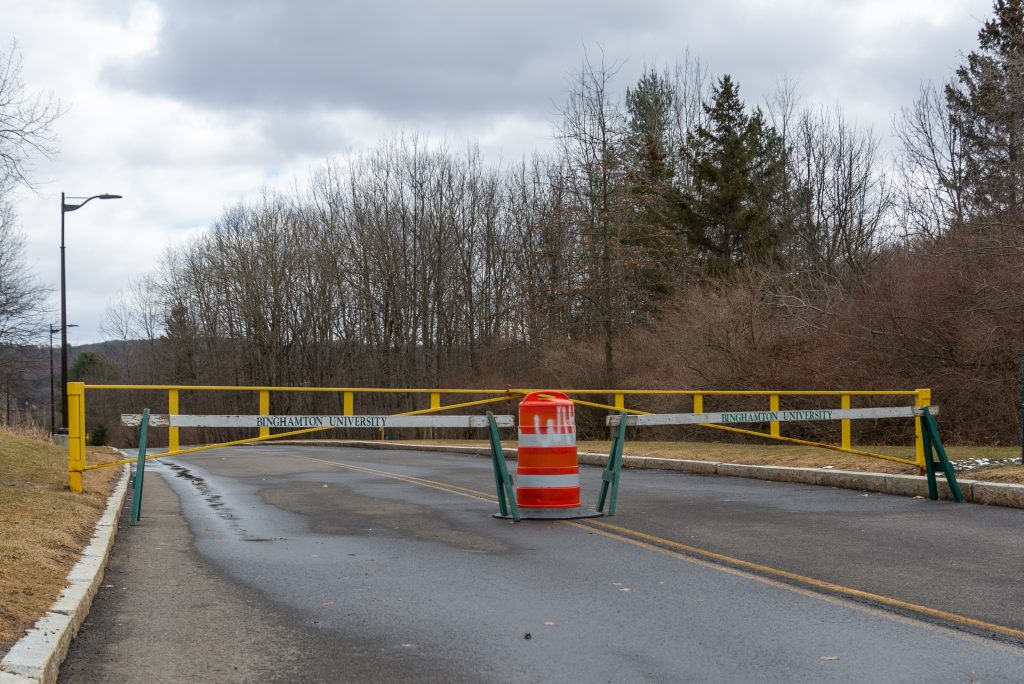Connector Road — one of the few back doors for commuters — is now closed due to the annual spring migration of amphibians awaking from their hibernation.
Connector Road runs behind Mountainview College and Hinman College, connecting East Access Road with West Drive. Due to the annual migration of yellow-spotted salamanders, who spend the winter hibernating in the woods surrounding College-in-the-Woods, the road will be partially closed from the gates of East Access Road to the gates by Mountainview College, leaving the pathway only open from Hinman College to Mountainview College. The closure allows for salamanders to cross and reach the Binghamton University Nature Preserve to breed, usually on the first warm rainy night in March, according to the BU Nature Preserve website. Students can expect Connector Road to be closed for the rest of the month of March, and at night in April.
According to Dylan Horvath, steward of natural areas at BU, the closure of the road in March is vital for local wildlife.
“It’s important [not only] for the yellow-spotted salamanders, but many other amphibians cross the road [on] warm rainy nights in spring,” Horvath said. “The yellow-spotted salamanders migrate from the woods around College-in-the-Woods to the waterways in the Nature Preserve. The salamanders spend most of the year underground, but they need to breed and lay their eggs in water.”
The closure of the road by the first week of March also allows for road salt to wash off, which in high concentrations is toxic to the yellow-spotted salamanders and other organisms with moist surfaces..
Horvath added that changes in climate may affect protocols in place protecting the annual migration.
“With climate change, we’ve been getting less snow, so the University wanted to open the Connector Road most of the year,” Horvath said. “Luckily, the salamanders were not forgotten and we still close the road for the month of March and at night in April.”
Horvath said climate change is also making it harder to predict the timing of the migration, which, during his first 10 years of observing the occurrence, had typically occurred from March 23 to March 26. Since 2011, the migration has been intermittent, occurring to Horvath, due to warm spells or snowfall that can cause the migration to pause.
Luke Karniewich, a junior majoring in economics, said he commutes every day to campus and often takes the back entrance to get to Lot M, instead of waiting in the lines of cars some students have come accustomed to. Karniewich claimed it is a hindrance on his daily commute, but said he acknowledged the importance of the salamanders.
Zach Miller, a sophomore majoring in economics and resident of Mountainview College, said closing Connector Road is an important way to prevent “unnatural drops” in the salamander population.
Many students and faculty have participated in research involving the animals found in the BU Nature Preserve, including amphibians and their migration, according to Julian Shepherd, an associate professor of biology and chairman of the BU Environment Committee — a committee which oversees the Nature Preserve.
Shepherd said that research by Victor Lamoureux, a professor of biology at Broome Community College, found important results in amphibian migration patterns.
“Radio transmitters [were] implanted in frogs and salamanders to track their movement,” Shepherd said. “Lamoureux found that green frogs didn’t overwinter in the pond as expected but overwintered in streams, steeps, beaver dams, anywhere with water that remained unfrozen over the winter.”
Shepherd and Horvath said the yellow-spotted salamander is an animal of interest in research, but also spring peepers, a species of frog, newts and toads. Horvath added that the eastern newt is the only newt species found in the Nature Preserve, and that mink, fisher, beavers, muskrats, opossums and raccoons are rarely found out on the road at night.
As steward of natural areas at BU, Horvath regularly watches and records the yearly migration of various animals.
“The coolest thing to me has been tiny gray animals that were so fast that I couldn’t tell what they were,” Horvath said. “At less than two inches long, they were hard to see, but I found out that the tiny animals are pygmy shrews. Pygmy shrews are one of the smallest mammals in the world, and we have them here.”
According to Shepard, the road should be closed for a longer time to assist in the salamander migration.
“The administration closes the Connector Road to facilitate the migration to the ponds, which is good, but opens it again before the amphibians have migrated back to the woods, which is not so good,” Shepard said.
While the annual migration has not begun yet, Shepard said when it does, students at BU can all expect their Nature Preserve steward to track the famed yellow-spotted salamanders making their way to the ponds for the mating season.



